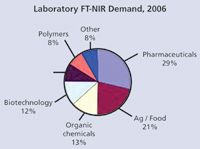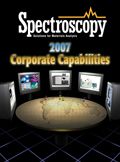Market Profile: FT-NIR
Fourier Transform Near Infrared (FT-NIR) spectroscopy is the most recent addition to laboratory NIR technologies. This technological advancement is heavily utilized in the most modern and fastest growing industries, examples of which include pharmaceuticals and biotechnology.
Fourier Transform Near Infrared (FT-NIR) spectroscopy is the most recent addition to laboratory NIR technologies. This technological advancement is heavily utilized in the most modern and fastest growing industries, examples of which include pharmaceuticals and biotechnology.

Laboratory FT-NIR Demand, 2006
FT-NIR spectrometers utilize interferometers, which split the source light. One beam is reflected off a fixed mirror, while the other is reflected off an oscillating mirror; the two beams are then recombined, creating an interferogram, to which a Fourier Transform is applied to produce a spectrum. There are several advantages of FT-NIR instruments over conventional dispersive NIR instruments. Given that FT-NIR instruments measure the entire spectrum simultaneously, they are faster, and more sensitive, with lower noise levels. The inherent design of an FT-NIR system also provides for an internal calibration on every scan, which is known as Conne's advantage.
The pharmaceutical industry is the leading user of FT-NIR instruments, due in large part to Conne's advantage, which eliminates inter-instrument variability and allows for easy transfer of methods and calibrations between instruments. This is critical to all functions, such as quality control, research & development, and coordination with process instrumentation. The food industry is the second largest user of FT-NIR instrumentation, with much of its demand derived from the large installed base of conventional dispersive NIR systems that have long been used in that area. The worldwide market for FT-NIR instrumentation will be around $74 million in 2006, and should continue to see annual average growth of 6% to 8% over the foreseeable future.
The foregoing data were extracted from SDi's market analysis and perspectives report entitled Edition Global Assessment Report, 9th Edition: The Laboratory Life Science and Analytical Instrument Industry, September 2006. For more information, contact Stuart Press, Senior Consultant, Strategic Directions International, Inc., 6242 Westchester Parkway, Suite 100, Los Angeles, CA 90045, (310) 641-4982, fax: (310) 641-8851, www.strategic-directions.com
Market Profile: Mass, Molecular, and Atomic Spectroscopy
December 1st 2018Mass spectrometry, molecular and atomic spectroscopy technologies combine to represent more than a fifth of the overall market for laboratory analytical instrumentation. These techniques are perhaps the most broadly used instruments, with utility in pharmaceuticals and other life sciences, chemicals, environmental, food, clinical/Dx and other applications.
